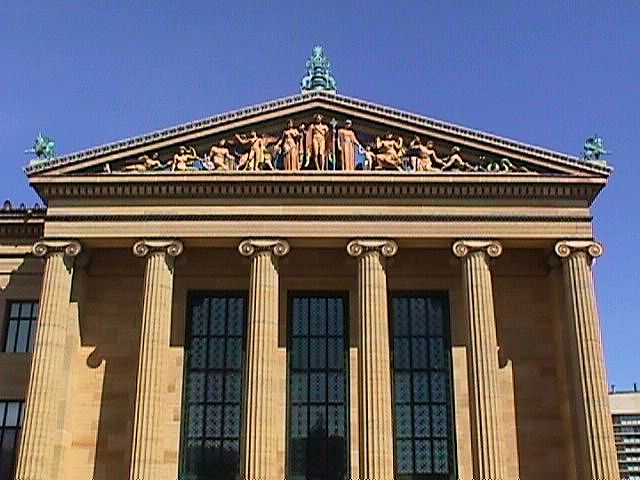C. Paul Jennewein
Western Civilization
Tympanum Sculpture of the North Wing of the Philadelphia Museum of Art
1932-33
Terra Cotta
On October 9, 1932, the completed sculpture was unveiled at the factory, and then for ten weeks, between November 1932 and January 1933, a team of seemingly tiny workmen assembled the brightly colored colossi high on the facade of the museum. Zeus, the central figure in composition, stoof twelve feet tall and weighed almost a ton. The scaffolding was pulled away, revealing the work full view, in March 1933.
Paul Jennewein's mighty ensemble of stiffly posed figures traced its historical pedigree to the pedimental statuary created for the great Greek temples of the first half of the fifth century, notable the Temple of Zeus at Olumpia and the Temple of Aphaia on the island of Aegina. Indeed, the east pediment of Olympia centers on a standing Zeus, like the grouping in Philadelphia. The potent and deliberately antinaturalistic polychromy of Jennewein's figures was also based on what Solon judged to be ancient principles, although these were translated into modern materials with a resulting increase in stridency.
Just as the figure types and their identities were ancient, they also told a story that was a pastiche of feats and foibles from classical mythology. As Jennewein explained it, the pediment depicts the influences that have shaped Western art, with the central, supreme Zeus (jupitur) representing the "creative force or the will of man," flanked by mythological figures who symbolize the two great defining themes of human art and civilization, sacred and profane love. These Jennewein called, "the physical and the spiritual elements in the nature of man.
[To] the left of Zeus gather exemplars of sacred love, starting with Ceres (Demeter), goddess of agriculture, marriage, and other aspects of peaceful living. She holds the hand of Triptolemus, the child rescued from sacrifice by his mother so that he might teach mankind the value of life and work. Behind the youth branches the laurel tree into which the nymph Daphne was transformed to save here from profanation by the pursuing Apollo, and beside the tree sits Ariadne, who aided her lover Theseus's escape from the labyrinth after he had slain the human-devouring Minotour. Theseus grapples with the Minotour by side, and in the far corner of the pediment the belly-crawling python represents the depths "from which our spiritual natures are compelled to rise.
[To the right of Zeus] are arrayed representations of profane love, defined by Jennewein as "the physical, mechanical and scientific side of life." Aprodite (Venus) stands next to the central Zeus, symbolizing love, beauty, and fruitfulness, with her son Eros (Cupid) at her side. Behind the little god of love is the lion into which Hippomenes was changed for defiling holy ground with his lust for Atalanta, the swift runner whom he had overtaken with the famous strategem of three golden apples. Eros raises a hand in vain to warn the kneeling Adonis, beloved of Aphrodite, who is destined to disobey the goddess and hunt the boar that will slay him. Beyond Adonis sits Nous, the Greek personification of human reason, and in the corner, Eos (Aurora)--the dawn of the mind--turns from the owl, bird of the night."
David B. Brownlee, Making a Modern Classic: the architecture of the Philadelphia Museum of Art (Philadelphia: Philadelphia Museum of Art, 1997), pp. 91-95.
| |

|